Home Project P2: Q&A on HRM, Communication, and Project Risks Analysis
VerifiedAdded on 2023/04/24
|11
|4874
|385
Homework Assignment
AI Summary
This assignment encompasses a comprehensive analysis of human resource management (HRM) methods, communication networks, and project risk assessment. The student addresses questions on HRM techniques, strategies for managing project resources in various scenarios (resource requirements, skills gaps, performance shortfalls, motivation, and conflict resolution), and performance evaluation criteria. The assignment also includes an exploration of communication networks within an organization, including identification of network types, relevant uses, and maintenance strategies. Furthermore, the student delves into project risk management by defining risk objectives, identifying relevant standards, and analyzing project context. The student provides examples of risk objectives, relevant standards and legislation for risk management, and internal/external contexts for a project. The student also examines the importance of identifying and resolving communication and information management system issues. The assignment offers a detailed overview of project management principles and their practical application, providing insights into stakeholder engagement, security, and audit requirements.
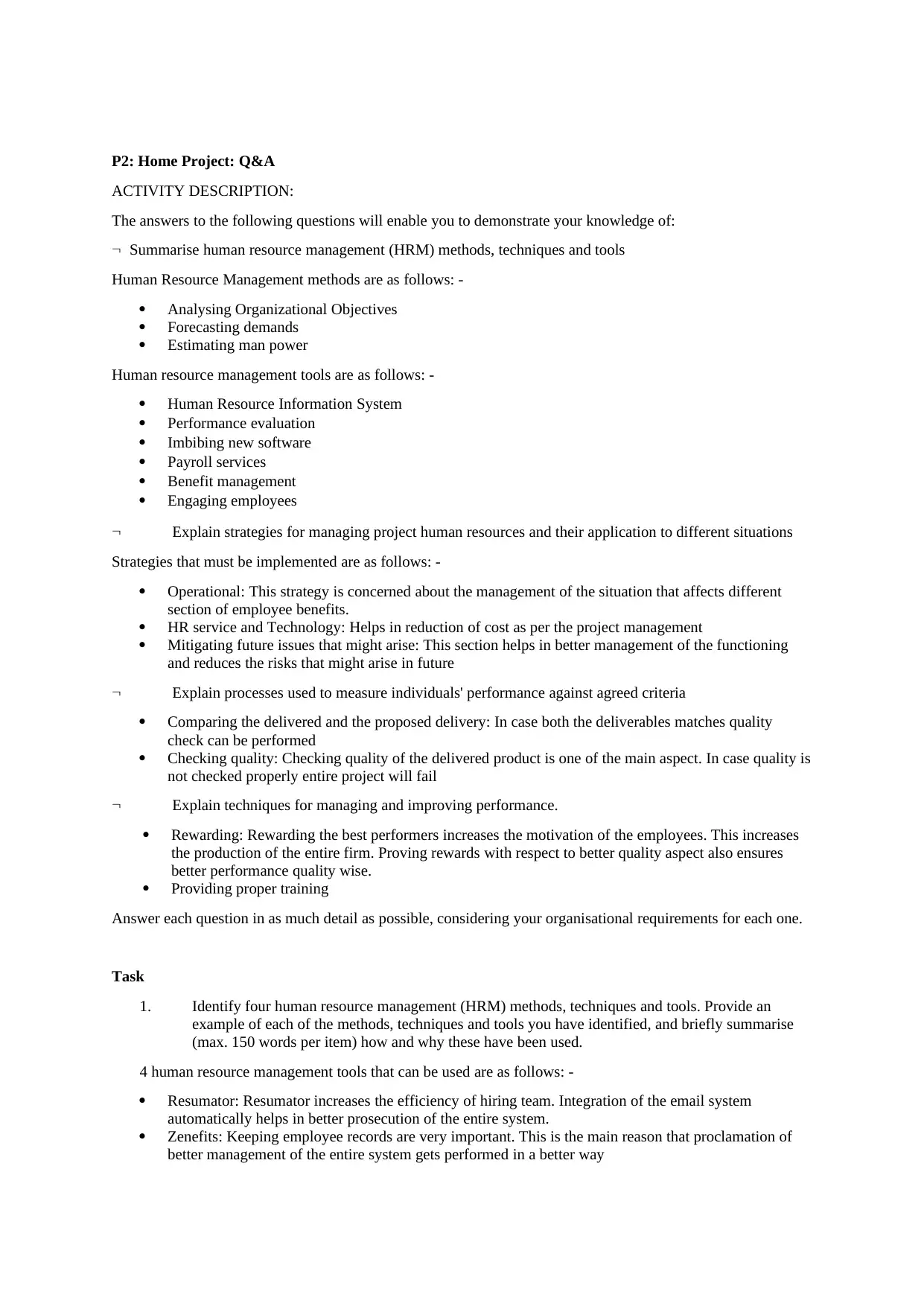
P2: Home Project: Q&A
ACTIVITY DESCRIPTION:
The answers to the following questions will enable you to demonstrate your knowledge of:
Summarise human resource management (HRM) methods, techniques and tools
Human Resource Management methods are as follows: -
Analysing Organizational Objectives
Forecasting demands
Estimating man power
Human resource management tools are as follows: -
Human Resource Information System
Performance evaluation
Imbibing new software
Payroll services
Benefit management
Engaging employees
Explain strategies for managing project human resources and their application to different situations
Strategies that must be implemented are as follows: -
Operational: This strategy is concerned about the management of the situation that affects different
section of employee benefits.
HR service and Technology: Helps in reduction of cost as per the project management
Mitigating future issues that might arise: This section helps in better management of the functioning
and reduces the risks that might arise in future
Explain processes used to measure individuals' performance against agreed criteria
Comparing the delivered and the proposed delivery: In case both the deliverables matches quality
check can be performed
Checking quality: Checking quality of the delivered product is one of the main aspect. In case quality is
not checked properly entire project will fail
Explain techniques for managing and improving performance.
Rewarding: Rewarding the best performers increases the motivation of the employees. This increases
the production of the entire firm. Proving rewards with respect to better quality aspect also ensures
better performance quality wise.
Providing proper training
Answer each question in as much detail as possible, considering your organisational requirements for each one.
Task
1. Identify four human resource management (HRM) methods, techniques and tools. Provide an
example of each of the methods, techniques and tools you have identified, and briefly summarise
(max. 150 words per item) how and why these have been used.
4 human resource management tools that can be used are as follows: -
Resumator: Resumator increases the efficiency of hiring team. Integration of the email system
automatically helps in better prosecution of the entire system.
Zenefits: Keeping employee records are very important. This is the main reason that proclamation of
better management of the entire system gets performed in a better way
ACTIVITY DESCRIPTION:
The answers to the following questions will enable you to demonstrate your knowledge of:
Summarise human resource management (HRM) methods, techniques and tools
Human Resource Management methods are as follows: -
Analysing Organizational Objectives
Forecasting demands
Estimating man power
Human resource management tools are as follows: -
Human Resource Information System
Performance evaluation
Imbibing new software
Payroll services
Benefit management
Engaging employees
Explain strategies for managing project human resources and their application to different situations
Strategies that must be implemented are as follows: -
Operational: This strategy is concerned about the management of the situation that affects different
section of employee benefits.
HR service and Technology: Helps in reduction of cost as per the project management
Mitigating future issues that might arise: This section helps in better management of the functioning
and reduces the risks that might arise in future
Explain processes used to measure individuals' performance against agreed criteria
Comparing the delivered and the proposed delivery: In case both the deliverables matches quality
check can be performed
Checking quality: Checking quality of the delivered product is one of the main aspect. In case quality is
not checked properly entire project will fail
Explain techniques for managing and improving performance.
Rewarding: Rewarding the best performers increases the motivation of the employees. This increases
the production of the entire firm. Proving rewards with respect to better quality aspect also ensures
better performance quality wise.
Providing proper training
Answer each question in as much detail as possible, considering your organisational requirements for each one.
Task
1. Identify four human resource management (HRM) methods, techniques and tools. Provide an
example of each of the methods, techniques and tools you have identified, and briefly summarise
(max. 150 words per item) how and why these have been used.
4 human resource management tools that can be used are as follows: -
Resumator: Resumator increases the efficiency of hiring team. Integration of the email system
automatically helps in better prosecution of the entire system.
Zenefits: Keeping employee records are very important. This is the main reason that proclamation of
better management of the entire system gets performed in a better way
Paraphrase This Document
Need a fresh take? Get an instant paraphrase of this document with our AI Paraphraser
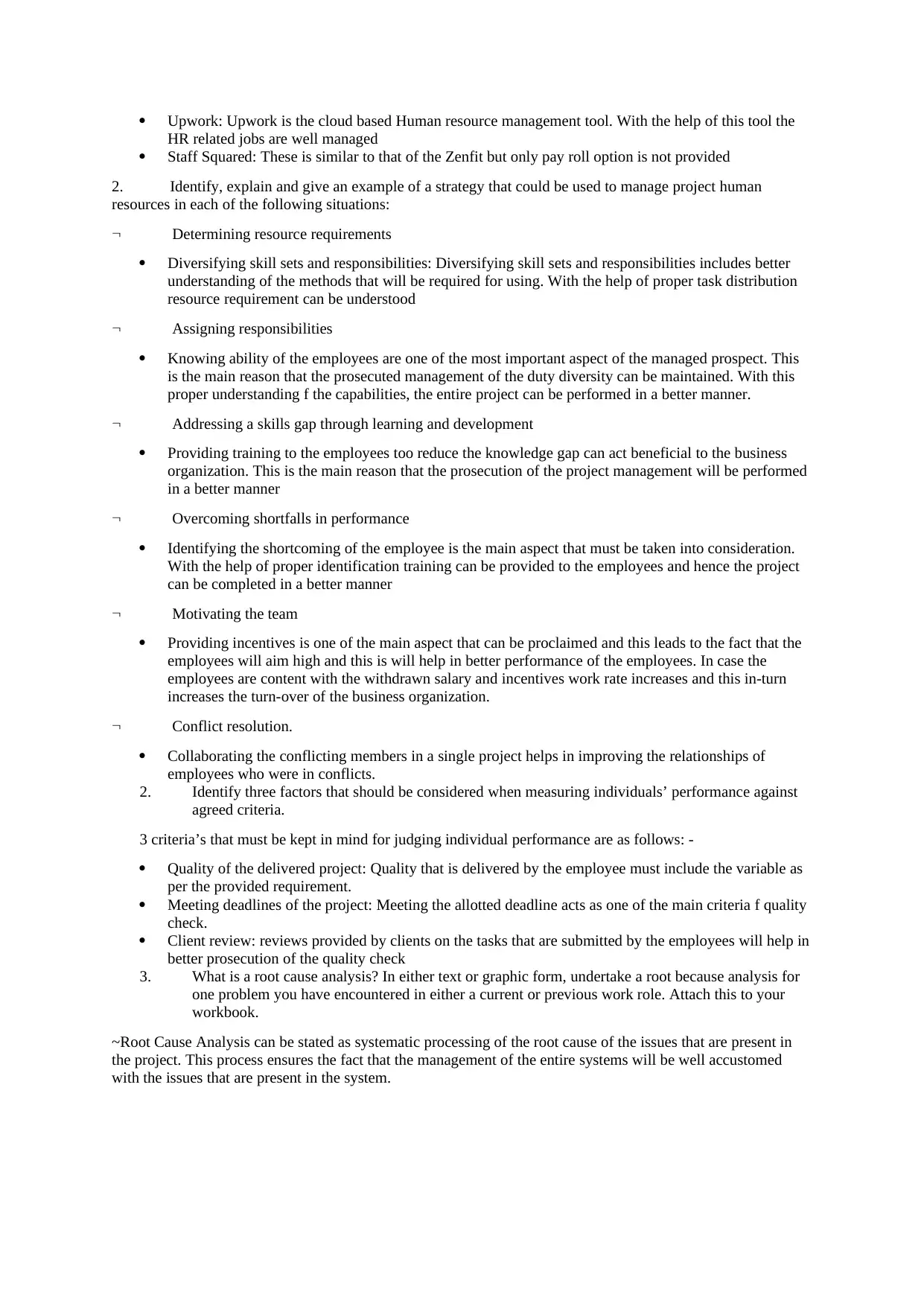
Upwork: Upwork is the cloud based Human resource management tool. With the help of this tool the
HR related jobs are well managed
Staff Squared: These is similar to that of the Zenfit but only pay roll option is not provided
2. Identify, explain and give an example of a strategy that could be used to manage project human
resources in each of the following situations:
Determining resource requirements
Diversifying skill sets and responsibilities: Diversifying skill sets and responsibilities includes better
understanding of the methods that will be required for using. With the help of proper task distribution
resource requirement can be understood
Assigning responsibilities
Knowing ability of the employees are one of the most important aspect of the managed prospect. This
is the main reason that the prosecuted management of the duty diversity can be maintained. With this
proper understanding f the capabilities, the entire project can be performed in a better manner.
Addressing a skills gap through learning and development
Providing training to the employees too reduce the knowledge gap can act beneficial to the business
organization. This is the main reason that the prosecution of the project management will be performed
in a better manner
Overcoming shortfalls in performance
Identifying the shortcoming of the employee is the main aspect that must be taken into consideration.
With the help of proper identification training can be provided to the employees and hence the project
can be completed in a better manner
Motivating the team
Providing incentives is one of the main aspect that can be proclaimed and this leads to the fact that the
employees will aim high and this is will help in better performance of the employees. In case the
employees are content with the withdrawn salary and incentives work rate increases and this in-turn
increases the turn-over of the business organization.
Conflict resolution.
Collaborating the conflicting members in a single project helps in improving the relationships of
employees who were in conflicts.
2. Identify three factors that should be considered when measuring individuals’ performance against
agreed criteria.
3 criteria’s that must be kept in mind for judging individual performance are as follows: -
Quality of the delivered project: Quality that is delivered by the employee must include the variable as
per the provided requirement.
Meeting deadlines of the project: Meeting the allotted deadline acts as one of the main criteria f quality
check.
Client review: reviews provided by clients on the tasks that are submitted by the employees will help in
better prosecution of the quality check
3. What is a root cause analysis? In either text or graphic form, undertake a root because analysis for
one problem you have encountered in either a current or previous work role. Attach this to your
workbook.
~Root Cause Analysis can be stated as systematic processing of the root cause of the issues that are present in
the project. This process ensures the fact that the management of the entire systems will be well accustomed
with the issues that are present in the system.
HR related jobs are well managed
Staff Squared: These is similar to that of the Zenfit but only pay roll option is not provided
2. Identify, explain and give an example of a strategy that could be used to manage project human
resources in each of the following situations:
Determining resource requirements
Diversifying skill sets and responsibilities: Diversifying skill sets and responsibilities includes better
understanding of the methods that will be required for using. With the help of proper task distribution
resource requirement can be understood
Assigning responsibilities
Knowing ability of the employees are one of the most important aspect of the managed prospect. This
is the main reason that the prosecuted management of the duty diversity can be maintained. With this
proper understanding f the capabilities, the entire project can be performed in a better manner.
Addressing a skills gap through learning and development
Providing training to the employees too reduce the knowledge gap can act beneficial to the business
organization. This is the main reason that the prosecution of the project management will be performed
in a better manner
Overcoming shortfalls in performance
Identifying the shortcoming of the employee is the main aspect that must be taken into consideration.
With the help of proper identification training can be provided to the employees and hence the project
can be completed in a better manner
Motivating the team
Providing incentives is one of the main aspect that can be proclaimed and this leads to the fact that the
employees will aim high and this is will help in better performance of the employees. In case the
employees are content with the withdrawn salary and incentives work rate increases and this in-turn
increases the turn-over of the business organization.
Conflict resolution.
Collaborating the conflicting members in a single project helps in improving the relationships of
employees who were in conflicts.
2. Identify three factors that should be considered when measuring individuals’ performance against
agreed criteria.
3 criteria’s that must be kept in mind for judging individual performance are as follows: -
Quality of the delivered project: Quality that is delivered by the employee must include the variable as
per the provided requirement.
Meeting deadlines of the project: Meeting the allotted deadline acts as one of the main criteria f quality
check.
Client review: reviews provided by clients on the tasks that are submitted by the employees will help in
better prosecution of the quality check
3. What is a root cause analysis? In either text or graphic form, undertake a root because analysis for
one problem you have encountered in either a current or previous work role. Attach this to your
workbook.
~Root Cause Analysis can be stated as systematic processing of the root cause of the issues that are present in
the project. This process ensures the fact that the management of the entire systems will be well accustomed
with the issues that are present in the system.
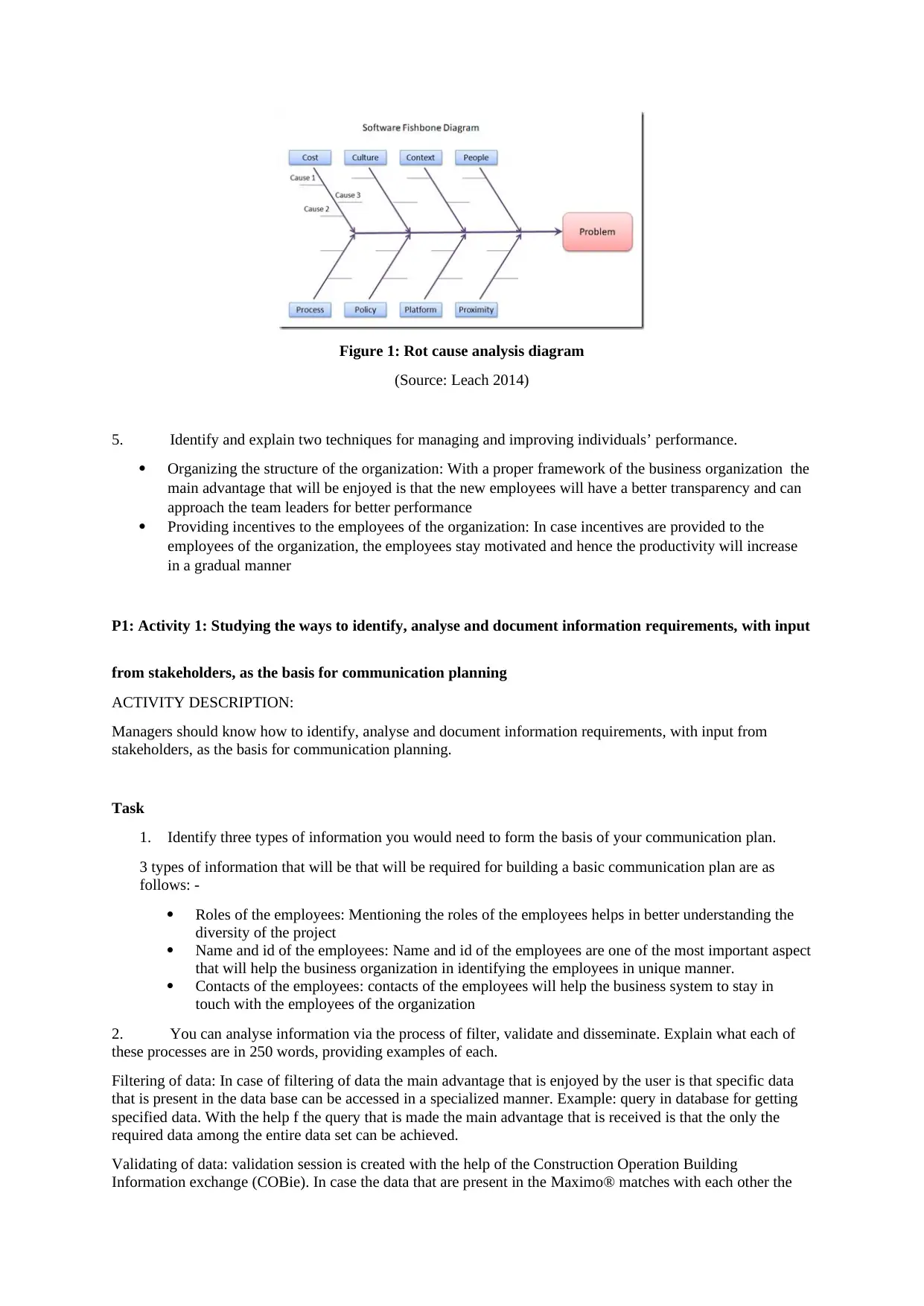
Figure 1: Rot cause analysis diagram
(Source: Leach 2014)
5. Identify and explain two techniques for managing and improving individuals’ performance.
Organizing the structure of the organization: With a proper framework of the business organization the
main advantage that will be enjoyed is that the new employees will have a better transparency and can
approach the team leaders for better performance
Providing incentives to the employees of the organization: In case incentives are provided to the
employees of the organization, the employees stay motivated and hence the productivity will increase
in a gradual manner
P1: Activity 1: Studying the ways to identify, analyse and document information requirements, with input
from stakeholders, as the basis for communication planning
ACTIVITY DESCRIPTION:
Managers should know how to identify, analyse and document information requirements, with input from
stakeholders, as the basis for communication planning.
Task
1. Identify three types of information you would need to form the basis of your communication plan.
3 types of information that will be that will be required for building a basic communication plan are as
follows: -
Roles of the employees: Mentioning the roles of the employees helps in better understanding the
diversity of the project
Name and id of the employees: Name and id of the employees are one of the most important aspect
that will help the business organization in identifying the employees in unique manner.
Contacts of the employees: contacts of the employees will help the business system to stay in
touch with the employees of the organization
2. You can analyse information via the process of filter, validate and disseminate. Explain what each of
these processes are in 250 words, providing examples of each.
Filtering of data: In case of filtering of data the main advantage that is enjoyed by the user is that specific data
that is present in the data base can be accessed in a specialized manner. Example: query in database for getting
specified data. With the help f the query that is made the main advantage that is received is that the only the
required data among the entire data set can be achieved.
Validating of data: validation session is created with the help of the Construction Operation Building
Information exchange (COBie). In case the data that are present in the Maximo® matches with each other the
(Source: Leach 2014)
5. Identify and explain two techniques for managing and improving individuals’ performance.
Organizing the structure of the organization: With a proper framework of the business organization the
main advantage that will be enjoyed is that the new employees will have a better transparency and can
approach the team leaders for better performance
Providing incentives to the employees of the organization: In case incentives are provided to the
employees of the organization, the employees stay motivated and hence the productivity will increase
in a gradual manner
P1: Activity 1: Studying the ways to identify, analyse and document information requirements, with input
from stakeholders, as the basis for communication planning
ACTIVITY DESCRIPTION:
Managers should know how to identify, analyse and document information requirements, with input from
stakeholders, as the basis for communication planning.
Task
1. Identify three types of information you would need to form the basis of your communication plan.
3 types of information that will be that will be required for building a basic communication plan are as
follows: -
Roles of the employees: Mentioning the roles of the employees helps in better understanding the
diversity of the project
Name and id of the employees: Name and id of the employees are one of the most important aspect
that will help the business organization in identifying the employees in unique manner.
Contacts of the employees: contacts of the employees will help the business system to stay in
touch with the employees of the organization
2. You can analyse information via the process of filter, validate and disseminate. Explain what each of
these processes are in 250 words, providing examples of each.
Filtering of data: In case of filtering of data the main advantage that is enjoyed by the user is that specific data
that is present in the data base can be accessed in a specialized manner. Example: query in database for getting
specified data. With the help f the query that is made the main advantage that is received is that the only the
required data among the entire data set can be achieved.
Validating of data: validation session is created with the help of the Construction Operation Building
Information exchange (COBie). In case the data that are present in the Maximo® matches with each other the
⊘ This is a preview!⊘
Do you want full access?
Subscribe today to unlock all pages.

Trusted by 1+ million students worldwide
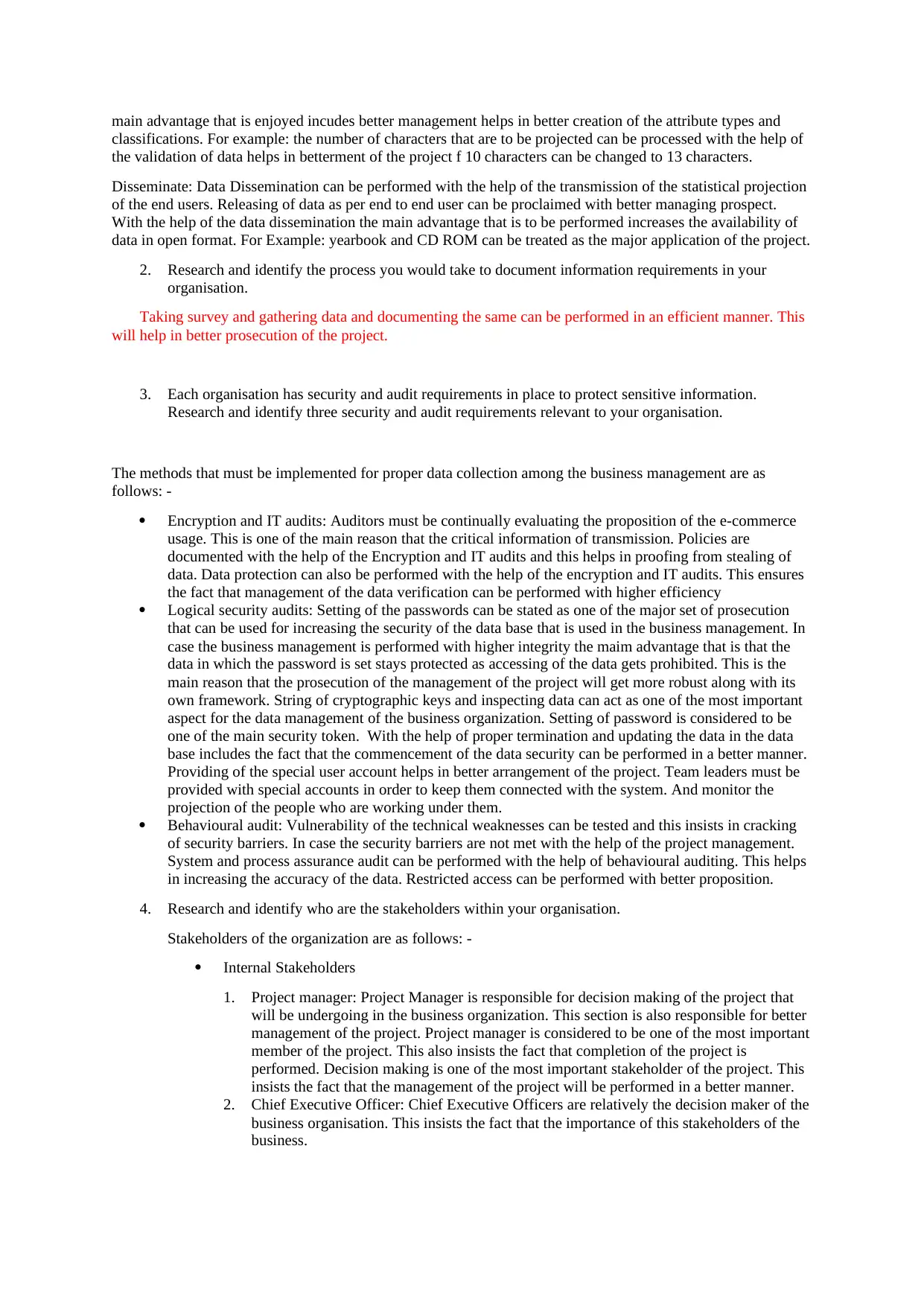
main advantage that is enjoyed incudes better management helps in better creation of the attribute types and
classifications. For example: the number of characters that are to be projected can be processed with the help of
the validation of data helps in betterment of the project f 10 characters can be changed to 13 characters.
Disseminate: Data Dissemination can be performed with the help of the transmission of the statistical projection
of the end users. Releasing of data as per end to end user can be proclaimed with better managing prospect.
With the help of the data dissemination the main advantage that is to be performed increases the availability of
data in open format. For Example: yearbook and CD ROM can be treated as the major application of the project.
2. Research and identify the process you would take to document information requirements in your
organisation.
Taking survey and gathering data and documenting the same can be performed in an efficient manner. This
will help in better prosecution of the project.
3. Each organisation has security and audit requirements in place to protect sensitive information.
Research and identify three security and audit requirements relevant to your organisation.
The methods that must be implemented for proper data collection among the business management are as
follows: -
Encryption and IT audits: Auditors must be continually evaluating the proposition of the e-commerce
usage. This is one of the main reason that the critical information of transmission. Policies are
documented with the help of the Encryption and IT audits and this helps in proofing from stealing of
data. Data protection can also be performed with the help of the encryption and IT audits. This ensures
the fact that management of the data verification can be performed with higher efficiency
Logical security audits: Setting of the passwords can be stated as one of the major set of prosecution
that can be used for increasing the security of the data base that is used in the business management. In
case the business management is performed with higher integrity the maim advantage that is that the
data in which the password is set stays protected as accessing of the data gets prohibited. This is the
main reason that the prosecution of the management of the project will get more robust along with its
own framework. String of cryptographic keys and inspecting data can act as one of the most important
aspect for the data management of the business organization. Setting of password is considered to be
one of the main security token. With the help of proper termination and updating the data in the data
base includes the fact that the commencement of the data security can be performed in a better manner.
Providing of the special user account helps in better arrangement of the project. Team leaders must be
provided with special accounts in order to keep them connected with the system. And monitor the
projection of the people who are working under them.
Behavioural audit: Vulnerability of the technical weaknesses can be tested and this insists in cracking
of security barriers. In case the security barriers are not met with the help of the project management.
System and process assurance audit can be performed with the help of behavioural auditing. This helps
in increasing the accuracy of the data. Restricted access can be performed with better proposition.
4. Research and identify who are the stakeholders within your organisation.
Stakeholders of the organization are as follows: -
Internal Stakeholders
1. Project manager: Project Manager is responsible for decision making of the project that
will be undergoing in the business organization. This section is also responsible for better
management of the project. Project manager is considered to be one of the most important
member of the project. This also insists the fact that completion of the project is
performed. Decision making is one of the most important stakeholder of the project. This
insists the fact that the management of the project will be performed in a better manner.
2. Chief Executive Officer: Chief Executive Officers are relatively the decision maker of the
business organisation. This insists the fact that the importance of this stakeholders of the
business.
classifications. For example: the number of characters that are to be projected can be processed with the help of
the validation of data helps in betterment of the project f 10 characters can be changed to 13 characters.
Disseminate: Data Dissemination can be performed with the help of the transmission of the statistical projection
of the end users. Releasing of data as per end to end user can be proclaimed with better managing prospect.
With the help of the data dissemination the main advantage that is to be performed increases the availability of
data in open format. For Example: yearbook and CD ROM can be treated as the major application of the project.
2. Research and identify the process you would take to document information requirements in your
organisation.
Taking survey and gathering data and documenting the same can be performed in an efficient manner. This
will help in better prosecution of the project.
3. Each organisation has security and audit requirements in place to protect sensitive information.
Research and identify three security and audit requirements relevant to your organisation.
The methods that must be implemented for proper data collection among the business management are as
follows: -
Encryption and IT audits: Auditors must be continually evaluating the proposition of the e-commerce
usage. This is one of the main reason that the critical information of transmission. Policies are
documented with the help of the Encryption and IT audits and this helps in proofing from stealing of
data. Data protection can also be performed with the help of the encryption and IT audits. This ensures
the fact that management of the data verification can be performed with higher efficiency
Logical security audits: Setting of the passwords can be stated as one of the major set of prosecution
that can be used for increasing the security of the data base that is used in the business management. In
case the business management is performed with higher integrity the maim advantage that is that the
data in which the password is set stays protected as accessing of the data gets prohibited. This is the
main reason that the prosecution of the management of the project will get more robust along with its
own framework. String of cryptographic keys and inspecting data can act as one of the most important
aspect for the data management of the business organization. Setting of password is considered to be
one of the main security token. With the help of proper termination and updating the data in the data
base includes the fact that the commencement of the data security can be performed in a better manner.
Providing of the special user account helps in better arrangement of the project. Team leaders must be
provided with special accounts in order to keep them connected with the system. And monitor the
projection of the people who are working under them.
Behavioural audit: Vulnerability of the technical weaknesses can be tested and this insists in cracking
of security barriers. In case the security barriers are not met with the help of the project management.
System and process assurance audit can be performed with the help of behavioural auditing. This helps
in increasing the accuracy of the data. Restricted access can be performed with better proposition.
4. Research and identify who are the stakeholders within your organisation.
Stakeholders of the organization are as follows: -
Internal Stakeholders
1. Project manager: Project Manager is responsible for decision making of the project that
will be undergoing in the business organization. This section is also responsible for better
management of the project. Project manager is considered to be one of the most important
member of the project. This also insists the fact that completion of the project is
performed. Decision making is one of the most important stakeholder of the project. This
insists the fact that the management of the project will be performed in a better manner.
2. Chief Executive Officer: Chief Executive Officers are relatively the decision maker of the
business organisation. This insists the fact that the importance of this stakeholders of the
business.
Paraphrase This Document
Need a fresh take? Get an instant paraphrase of this document with our AI Paraphraser
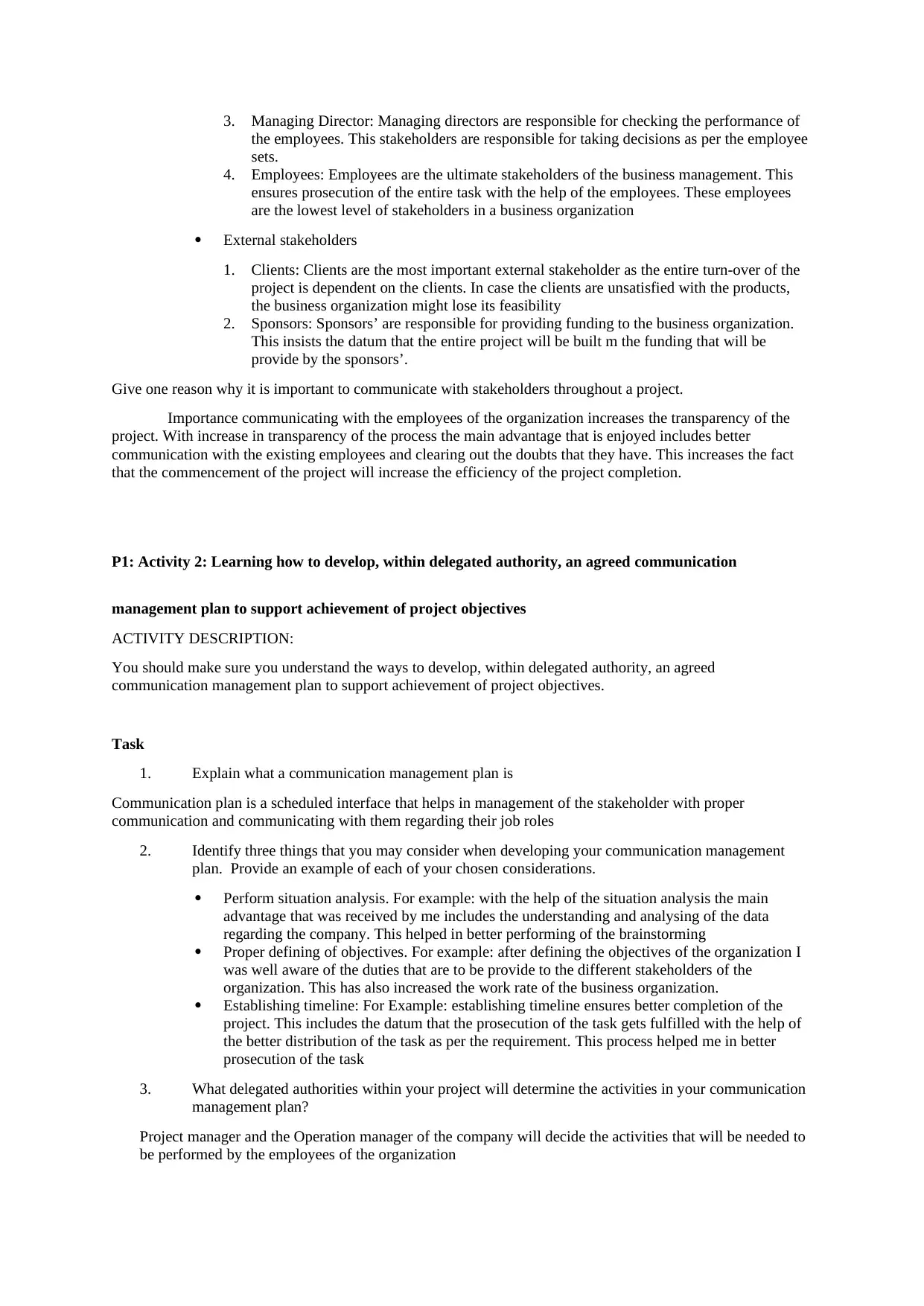
3. Managing Director: Managing directors are responsible for checking the performance of
the employees. This stakeholders are responsible for taking decisions as per the employee
sets.
4. Employees: Employees are the ultimate stakeholders of the business management. This
ensures prosecution of the entire task with the help of the employees. These employees
are the lowest level of stakeholders in a business organization
External stakeholders
1. Clients: Clients are the most important external stakeholder as the entire turn-over of the
project is dependent on the clients. In case the clients are unsatisfied with the products,
the business organization might lose its feasibility
2. Sponsors: Sponsors’ are responsible for providing funding to the business organization.
This insists the datum that the entire project will be built m the funding that will be
provide by the sponsors’.
Give one reason why it is important to communicate with stakeholders throughout a project.
Importance communicating with the employees of the organization increases the transparency of the
project. With increase in transparency of the process the main advantage that is enjoyed includes better
communication with the existing employees and clearing out the doubts that they have. This increases the fact
that the commencement of the project will increase the efficiency of the project completion.
P1: Activity 2: Learning how to develop, within delegated authority, an agreed communication
management plan to support achievement of project objectives
ACTIVITY DESCRIPTION:
You should make sure you understand the ways to develop, within delegated authority, an agreed
communication management plan to support achievement of project objectives.
Task
1. Explain what a communication management plan is
Communication plan is a scheduled interface that helps in management of the stakeholder with proper
communication and communicating with them regarding their job roles
2. Identify three things that you may consider when developing your communication management
plan. Provide an example of each of your chosen considerations.
Perform situation analysis. For example: with the help of the situation analysis the main
advantage that was received by me includes the understanding and analysing of the data
regarding the company. This helped in better performing of the brainstorming
Proper defining of objectives. For example: after defining the objectives of the organization I
was well aware of the duties that are to be provide to the different stakeholders of the
organization. This has also increased the work rate of the business organization.
Establishing timeline: For Example: establishing timeline ensures better completion of the
project. This includes the datum that the prosecution of the task gets fulfilled with the help of
the better distribution of the task as per the requirement. This process helped me in better
prosecution of the task
3. What delegated authorities within your project will determine the activities in your communication
management plan?
Project manager and the Operation manager of the company will decide the activities that will be needed to
be performed by the employees of the organization
the employees. This stakeholders are responsible for taking decisions as per the employee
sets.
4. Employees: Employees are the ultimate stakeholders of the business management. This
ensures prosecution of the entire task with the help of the employees. These employees
are the lowest level of stakeholders in a business organization
External stakeholders
1. Clients: Clients are the most important external stakeholder as the entire turn-over of the
project is dependent on the clients. In case the clients are unsatisfied with the products,
the business organization might lose its feasibility
2. Sponsors: Sponsors’ are responsible for providing funding to the business organization.
This insists the datum that the entire project will be built m the funding that will be
provide by the sponsors’.
Give one reason why it is important to communicate with stakeholders throughout a project.
Importance communicating with the employees of the organization increases the transparency of the
project. With increase in transparency of the process the main advantage that is enjoyed includes better
communication with the existing employees and clearing out the doubts that they have. This increases the fact
that the commencement of the project will increase the efficiency of the project completion.
P1: Activity 2: Learning how to develop, within delegated authority, an agreed communication
management plan to support achievement of project objectives
ACTIVITY DESCRIPTION:
You should make sure you understand the ways to develop, within delegated authority, an agreed
communication management plan to support achievement of project objectives.
Task
1. Explain what a communication management plan is
Communication plan is a scheduled interface that helps in management of the stakeholder with proper
communication and communicating with them regarding their job roles
2. Identify three things that you may consider when developing your communication management
plan. Provide an example of each of your chosen considerations.
Perform situation analysis. For example: with the help of the situation analysis the main
advantage that was received by me includes the understanding and analysing of the data
regarding the company. This helped in better performing of the brainstorming
Proper defining of objectives. For example: after defining the objectives of the organization I
was well aware of the duties that are to be provide to the different stakeholders of the
organization. This has also increased the work rate of the business organization.
Establishing timeline: For Example: establishing timeline ensures better completion of the
project. This includes the datum that the prosecution of the task gets fulfilled with the help of
the better distribution of the task as per the requirement. This process helped me in better
prosecution of the task
3. What delegated authorities within your project will determine the activities in your communication
management plan?
Project manager and the Operation manager of the company will decide the activities that will be needed to
be performed by the employees of the organization
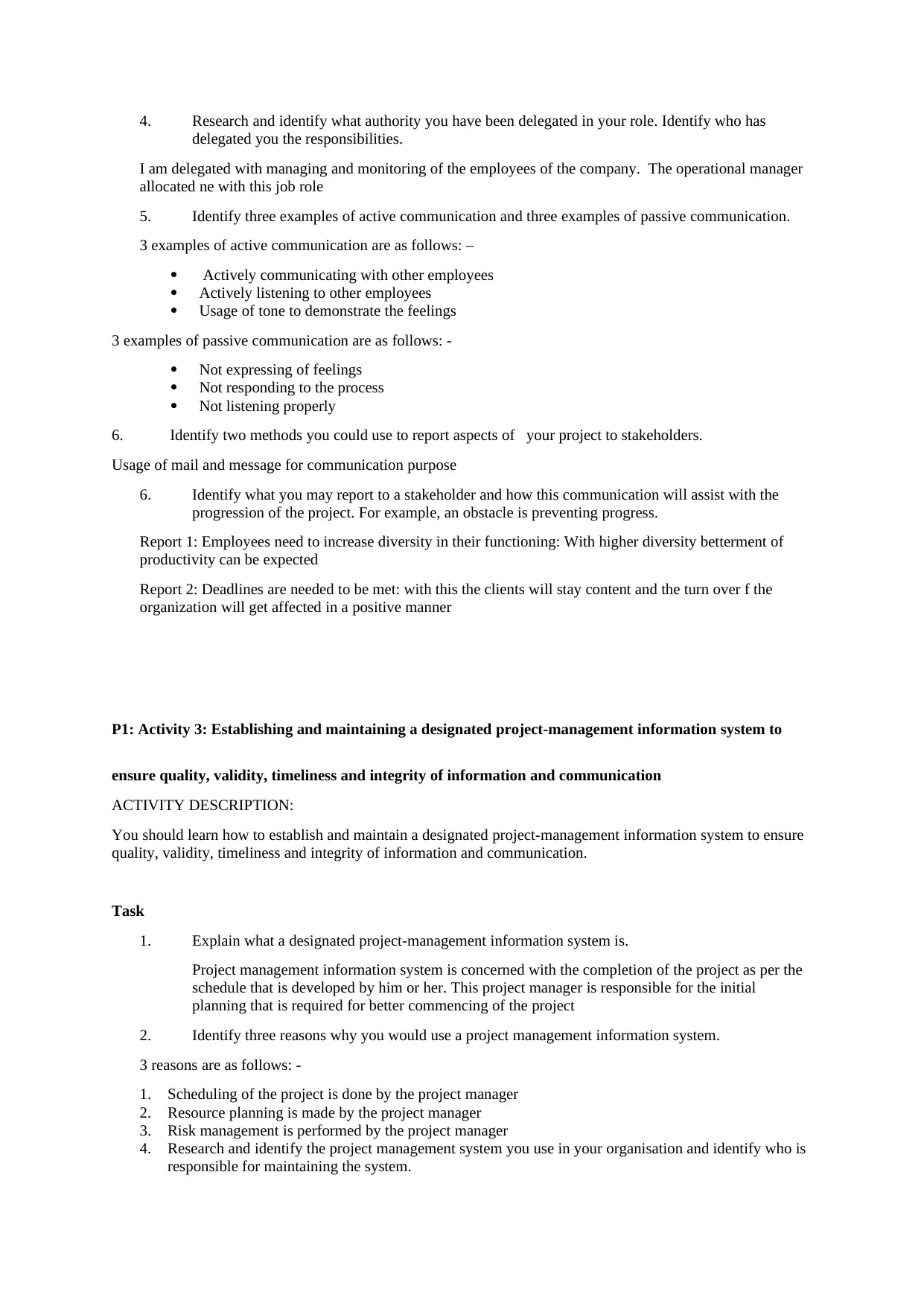
4. Research and identify what authority you have been delegated in your role. Identify who has
delegated you the responsibilities.
I am delegated with managing and monitoring of the employees of the company. The operational manager
allocated ne with this job role
5. Identify three examples of active communication and three examples of passive communication.
3 examples of active communication are as follows: –
Actively communicating with other employees
Actively listening to other employees
Usage of tone to demonstrate the feelings
3 examples of passive communication are as follows: -
Not expressing of feelings
Not responding to the process
Not listening properly
6. Identify two methods you could use to report aspects of your project to stakeholders.
Usage of mail and message for communication purpose
6. Identify what you may report to a stakeholder and how this communication will assist with the
progression of the project. For example, an obstacle is preventing progress.
Report 1: Employees need to increase diversity in their functioning: With higher diversity betterment of
productivity can be expected
Report 2: Deadlines are needed to be met: with this the clients will stay content and the turn over f the
organization will get affected in a positive manner
P1: Activity 3: Establishing and maintaining a designated project-management information system to
ensure quality, validity, timeliness and integrity of information and communication
ACTIVITY DESCRIPTION:
You should learn how to establish and maintain a designated project-management information system to ensure
quality, validity, timeliness and integrity of information and communication.
Task
1. Explain what a designated project-management information system is.
Project management information system is concerned with the completion of the project as per the
schedule that is developed by him or her. This project manager is responsible for the initial
planning that is required for better commencing of the project
2. Identify three reasons why you would use a project management information system.
3 reasons are as follows: -
1. Scheduling of the project is done by the project manager
2. Resource planning is made by the project manager
3. Risk management is performed by the project manager
4. Research and identify the project management system you use in your organisation and identify who is
responsible for maintaining the system.
delegated you the responsibilities.
I am delegated with managing and monitoring of the employees of the company. The operational manager
allocated ne with this job role
5. Identify three examples of active communication and three examples of passive communication.
3 examples of active communication are as follows: –
Actively communicating with other employees
Actively listening to other employees
Usage of tone to demonstrate the feelings
3 examples of passive communication are as follows: -
Not expressing of feelings
Not responding to the process
Not listening properly
6. Identify two methods you could use to report aspects of your project to stakeholders.
Usage of mail and message for communication purpose
6. Identify what you may report to a stakeholder and how this communication will assist with the
progression of the project. For example, an obstacle is preventing progress.
Report 1: Employees need to increase diversity in their functioning: With higher diversity betterment of
productivity can be expected
Report 2: Deadlines are needed to be met: with this the clients will stay content and the turn over f the
organization will get affected in a positive manner
P1: Activity 3: Establishing and maintaining a designated project-management information system to
ensure quality, validity, timeliness and integrity of information and communication
ACTIVITY DESCRIPTION:
You should learn how to establish and maintain a designated project-management information system to ensure
quality, validity, timeliness and integrity of information and communication.
Task
1. Explain what a designated project-management information system is.
Project management information system is concerned with the completion of the project as per the
schedule that is developed by him or her. This project manager is responsible for the initial
planning that is required for better commencing of the project
2. Identify three reasons why you would use a project management information system.
3 reasons are as follows: -
1. Scheduling of the project is done by the project manager
2. Resource planning is made by the project manager
3. Risk management is performed by the project manager
4. Research and identify the project management system you use in your organisation and identify who is
responsible for maintaining the system.
⊘ This is a preview!⊘
Do you want full access?
Subscribe today to unlock all pages.

Trusted by 1+ million students worldwide
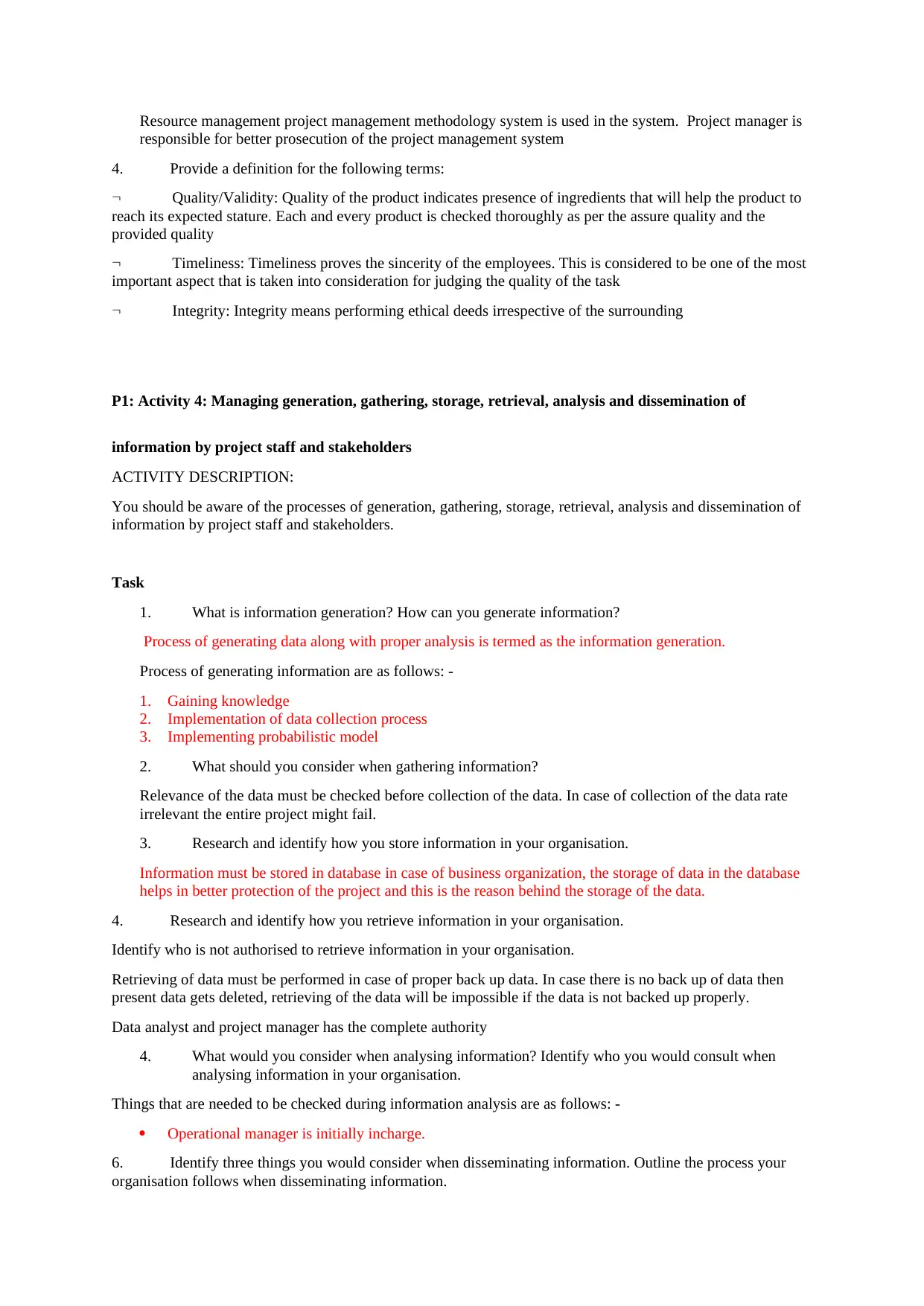
Resource management project management methodology system is used in the system. Project manager is
responsible for better prosecution of the project management system
4. Provide a definition for the following terms:
Quality/Validity: Quality of the product indicates presence of ingredients that will help the product to
reach its expected stature. Each and every product is checked thoroughly as per the assure quality and the
provided quality
Timeliness: Timeliness proves the sincerity of the employees. This is considered to be one of the most
important aspect that is taken into consideration for judging the quality of the task
Integrity: Integrity means performing ethical deeds irrespective of the surrounding
P1: Activity 4: Managing generation, gathering, storage, retrieval, analysis and dissemination of
information by project staff and stakeholders
ACTIVITY DESCRIPTION:
You should be aware of the processes of generation, gathering, storage, retrieval, analysis and dissemination of
information by project staff and stakeholders.
Task
1. What is information generation? How can you generate information?
Process of generating data along with proper analysis is termed as the information generation.
Process of generating information are as follows: -
1. Gaining knowledge
2. Implementation of data collection process
3. Implementing probabilistic model
2. What should you consider when gathering information?
Relevance of the data must be checked before collection of the data. In case of collection of the data rate
irrelevant the entire project might fail.
3. Research and identify how you store information in your organisation.
Information must be stored in database in case of business organization, the storage of data in the database
helps in better protection of the project and this is the reason behind the storage of the data.
4. Research and identify how you retrieve information in your organisation.
Identify who is not authorised to retrieve information in your organisation.
Retrieving of data must be performed in case of proper back up data. In case there is no back up of data then
present data gets deleted, retrieving of the data will be impossible if the data is not backed up properly.
Data analyst and project manager has the complete authority
4. What would you consider when analysing information? Identify who you would consult when
analysing information in your organisation.
Things that are needed to be checked during information analysis are as follows: -
Operational manager is initially incharge.
6. Identify three things you would consider when disseminating information. Outline the process your
organisation follows when disseminating information.
responsible for better prosecution of the project management system
4. Provide a definition for the following terms:
Quality/Validity: Quality of the product indicates presence of ingredients that will help the product to
reach its expected stature. Each and every product is checked thoroughly as per the assure quality and the
provided quality
Timeliness: Timeliness proves the sincerity of the employees. This is considered to be one of the most
important aspect that is taken into consideration for judging the quality of the task
Integrity: Integrity means performing ethical deeds irrespective of the surrounding
P1: Activity 4: Managing generation, gathering, storage, retrieval, analysis and dissemination of
information by project staff and stakeholders
ACTIVITY DESCRIPTION:
You should be aware of the processes of generation, gathering, storage, retrieval, analysis and dissemination of
information by project staff and stakeholders.
Task
1. What is information generation? How can you generate information?
Process of generating data along with proper analysis is termed as the information generation.
Process of generating information are as follows: -
1. Gaining knowledge
2. Implementation of data collection process
3. Implementing probabilistic model
2. What should you consider when gathering information?
Relevance of the data must be checked before collection of the data. In case of collection of the data rate
irrelevant the entire project might fail.
3. Research and identify how you store information in your organisation.
Information must be stored in database in case of business organization, the storage of data in the database
helps in better protection of the project and this is the reason behind the storage of the data.
4. Research and identify how you retrieve information in your organisation.
Identify who is not authorised to retrieve information in your organisation.
Retrieving of data must be performed in case of proper back up data. In case there is no back up of data then
present data gets deleted, retrieving of the data will be impossible if the data is not backed up properly.
Data analyst and project manager has the complete authority
4. What would you consider when analysing information? Identify who you would consult when
analysing information in your organisation.
Things that are needed to be checked during information analysis are as follows: -
Operational manager is initially incharge.
6. Identify three things you would consider when disseminating information. Outline the process your
organisation follows when disseminating information.
Paraphrase This Document
Need a fresh take? Get an instant paraphrase of this document with our AI Paraphraser
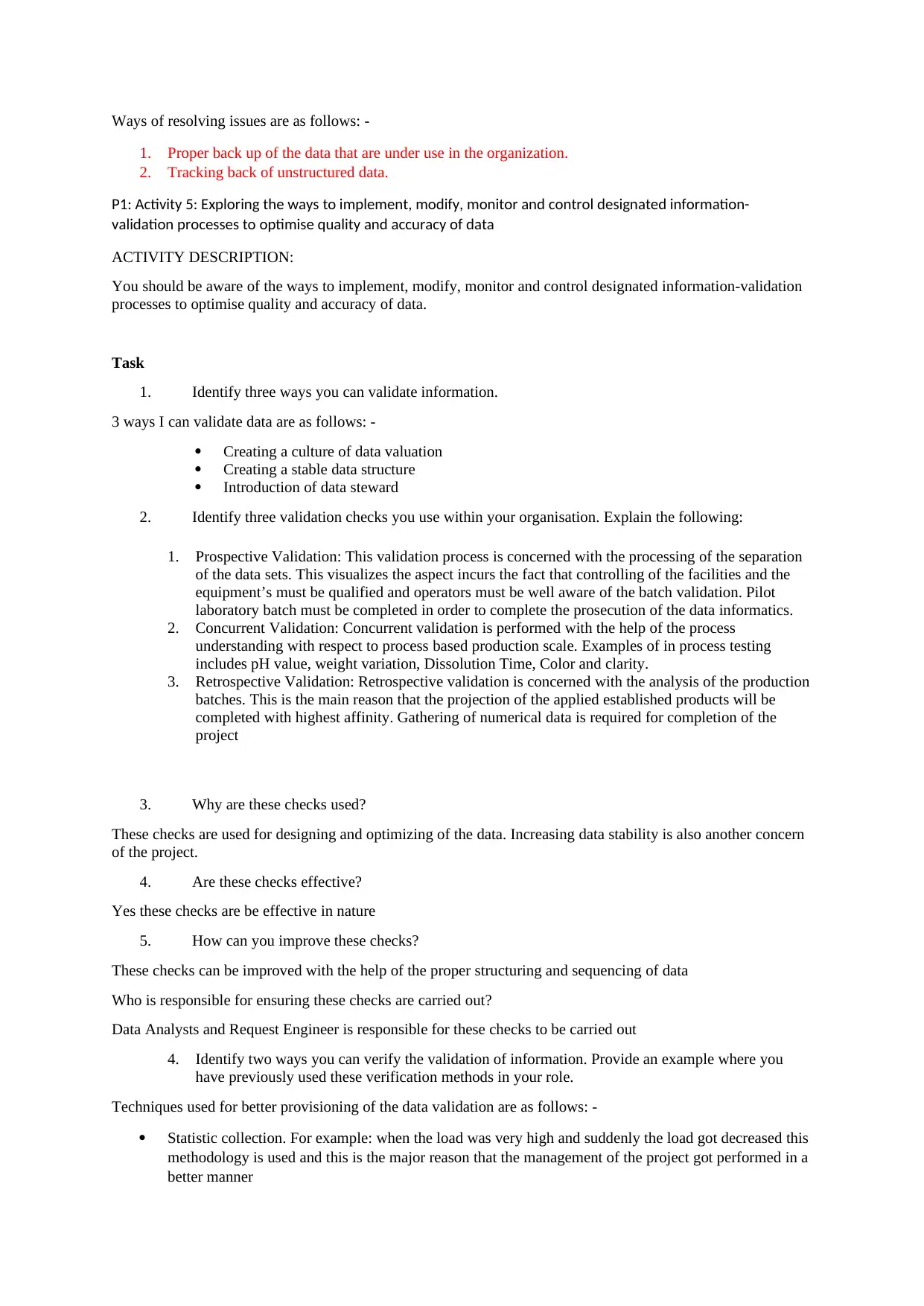
Ways of resolving issues are as follows: -
1. Proper back up of the data that are under use in the organization.
2. Tracking back of unstructured data.
P1: Activity 5: Exploring the ways to implement, modify, monitor and control designated information-
validation processes to optimise quality and accuracy of data
ACTIVITY DESCRIPTION:
You should be aware of the ways to implement, modify, monitor and control designated information-validation
processes to optimise quality and accuracy of data.
Task
1. Identify three ways you can validate information.
3 ways I can validate data are as follows: -
Creating a culture of data valuation
Creating a stable data structure
Introduction of data steward
2. Identify three validation checks you use within your organisation. Explain the following:
1. Prospective Validation: This validation process is concerned with the processing of the separation
of the data sets. This visualizes the aspect incurs the fact that controlling of the facilities and the
equipment’s must be qualified and operators must be well aware of the batch validation. Pilot
laboratory batch must be completed in order to complete the prosecution of the data informatics.
2. Concurrent Validation: Concurrent validation is performed with the help of the process
understanding with respect to process based production scale. Examples of in process testing
includes pH value, weight variation, Dissolution Time, Color and clarity.
3. Retrospective Validation: Retrospective validation is concerned with the analysis of the production
batches. This is the main reason that the projection of the applied established products will be
completed with highest affinity. Gathering of numerical data is required for completion of the
project
3. Why are these checks used?
These checks are used for designing and optimizing of the data. Increasing data stability is also another concern
of the project.
4. Are these checks effective?
Yes these checks are be effective in nature
5. How can you improve these checks?
These checks can be improved with the help of the proper structuring and sequencing of data
Who is responsible for ensuring these checks are carried out?
Data Analysts and Request Engineer is responsible for these checks to be carried out
4. Identify two ways you can verify the validation of information. Provide an example where you
have previously used these verification methods in your role.
Techniques used for better provisioning of the data validation are as follows: -
Statistic collection. For example: when the load was very high and suddenly the load got decreased this
methodology is used and this is the major reason that the management of the project got performed in a
better manner
1. Proper back up of the data that are under use in the organization.
2. Tracking back of unstructured data.
P1: Activity 5: Exploring the ways to implement, modify, monitor and control designated information-
validation processes to optimise quality and accuracy of data
ACTIVITY DESCRIPTION:
You should be aware of the ways to implement, modify, monitor and control designated information-validation
processes to optimise quality and accuracy of data.
Task
1. Identify three ways you can validate information.
3 ways I can validate data are as follows: -
Creating a culture of data valuation
Creating a stable data structure
Introduction of data steward
2. Identify three validation checks you use within your organisation. Explain the following:
1. Prospective Validation: This validation process is concerned with the processing of the separation
of the data sets. This visualizes the aspect incurs the fact that controlling of the facilities and the
equipment’s must be qualified and operators must be well aware of the batch validation. Pilot
laboratory batch must be completed in order to complete the prosecution of the data informatics.
2. Concurrent Validation: Concurrent validation is performed with the help of the process
understanding with respect to process based production scale. Examples of in process testing
includes pH value, weight variation, Dissolution Time, Color and clarity.
3. Retrospective Validation: Retrospective validation is concerned with the analysis of the production
batches. This is the main reason that the projection of the applied established products will be
completed with highest affinity. Gathering of numerical data is required for completion of the
project
3. Why are these checks used?
These checks are used for designing and optimizing of the data. Increasing data stability is also another concern
of the project.
4. Are these checks effective?
Yes these checks are be effective in nature
5. How can you improve these checks?
These checks can be improved with the help of the proper structuring and sequencing of data
Who is responsible for ensuring these checks are carried out?
Data Analysts and Request Engineer is responsible for these checks to be carried out
4. Identify two ways you can verify the validation of information. Provide an example where you
have previously used these verification methods in your role.
Techniques used for better provisioning of the data validation are as follows: -
Statistic collection. For example: when the load was very high and suddenly the load got decreased this
methodology is used and this is the major reason that the management of the project got performed in a
better manner
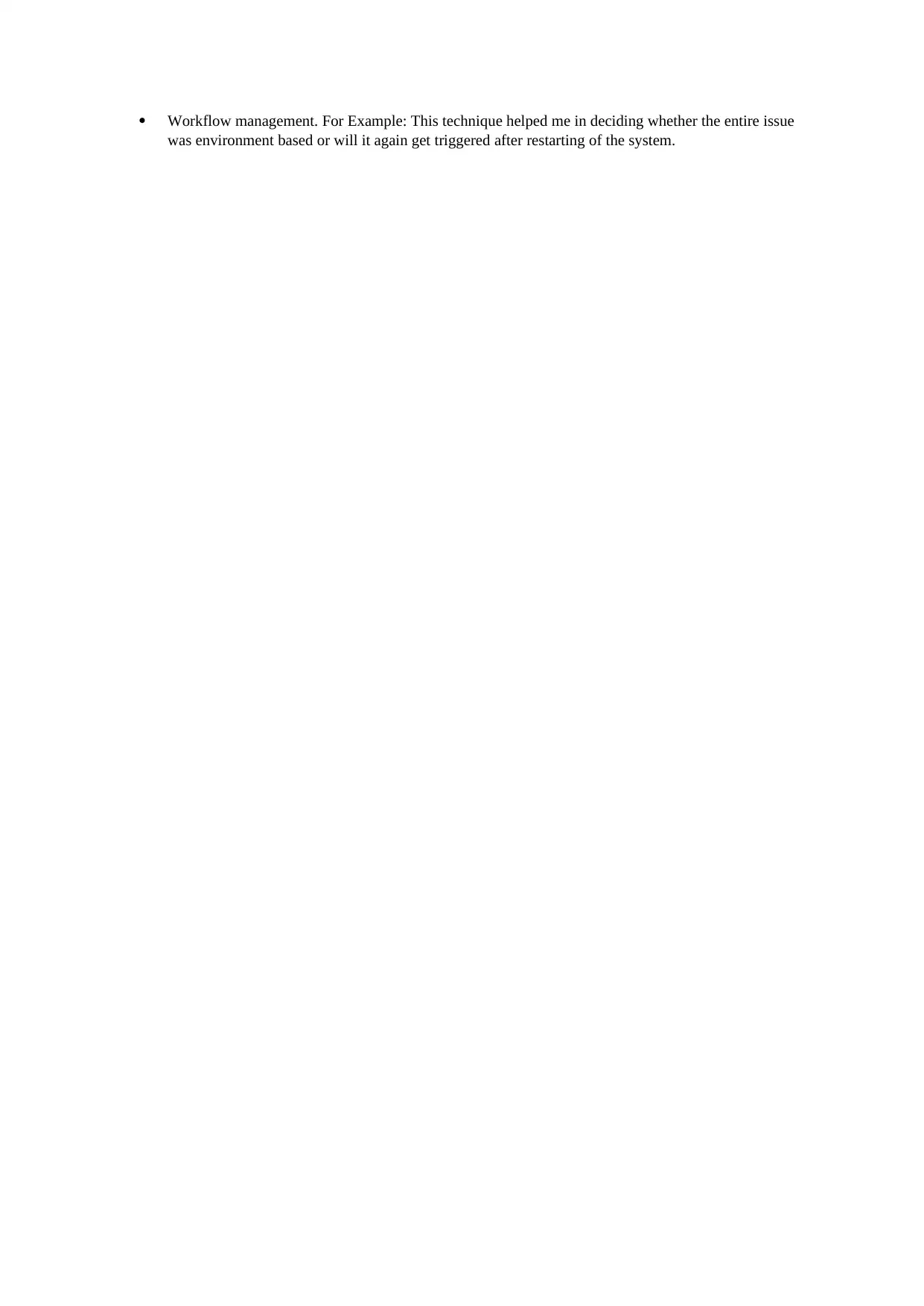
Workflow management. For Example: This technique helped me in deciding whether the entire issue
was environment based or will it again get triggered after restarting of the system.
was environment based or will it again get triggered after restarting of the system.
⊘ This is a preview!⊘
Do you want full access?
Subscribe today to unlock all pages.

Trusted by 1+ million students worldwide
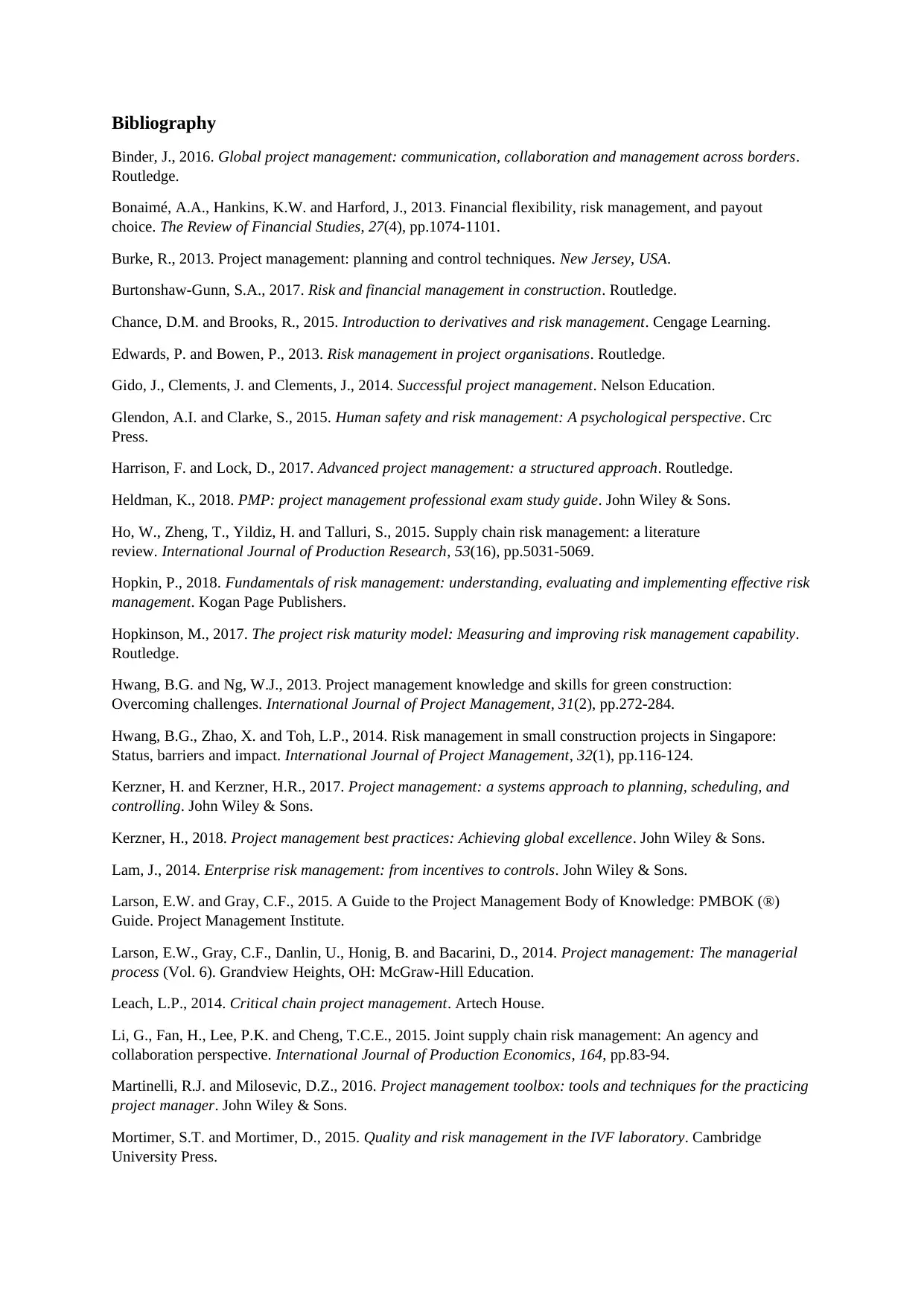
Bibliography
Binder, J., 2016. Global project management: communication, collaboration and management across borders.
Routledge.
Bonaimé, A.A., Hankins, K.W. and Harford, J., 2013. Financial flexibility, risk management, and payout
choice. The Review of Financial Studies, 27(4), pp.1074-1101.
Burke, R., 2013. Project management: planning and control techniques. New Jersey, USA.
Burtonshaw-Gunn, S.A., 2017. Risk and financial management in construction. Routledge.
Chance, D.M. and Brooks, R., 2015. Introduction to derivatives and risk management. Cengage Learning.
Edwards, P. and Bowen, P., 2013. Risk management in project organisations. Routledge.
Gido, J., Clements, J. and Clements, J., 2014. Successful project management. Nelson Education.
Glendon, A.I. and Clarke, S., 2015. Human safety and risk management: A psychological perspective. Crc
Press.
Harrison, F. and Lock, D., 2017. Advanced project management: a structured approach. Routledge.
Heldman, K., 2018. PMP: project management professional exam study guide. John Wiley & Sons.
Ho, W., Zheng, T., Yildiz, H. and Talluri, S., 2015. Supply chain risk management: a literature
review. International Journal of Production Research, 53(16), pp.5031-5069.
Hopkin, P., 2018. Fundamentals of risk management: understanding, evaluating and implementing effective risk
management. Kogan Page Publishers.
Hopkinson, M., 2017. The project risk maturity model: Measuring and improving risk management capability.
Routledge.
Hwang, B.G. and Ng, W.J., 2013. Project management knowledge and skills for green construction:
Overcoming challenges. International Journal of Project Management, 31(2), pp.272-284.
Hwang, B.G., Zhao, X. and Toh, L.P., 2014. Risk management in small construction projects in Singapore:
Status, barriers and impact. International Journal of Project Management, 32(1), pp.116-124.
Kerzner, H. and Kerzner, H.R., 2017. Project management: a systems approach to planning, scheduling, and
controlling. John Wiley & Sons.
Kerzner, H., 2018. Project management best practices: Achieving global excellence. John Wiley & Sons.
Lam, J., 2014. Enterprise risk management: from incentives to controls. John Wiley & Sons.
Larson, E.W. and Gray, C.F., 2015. A Guide to the Project Management Body of Knowledge: PMBOK (®)
Guide. Project Management Institute.
Larson, E.W., Gray, C.F., Danlin, U., Honig, B. and Bacarini, D., 2014. Project management: The managerial
process (Vol. 6). Grandview Heights, OH: McGraw-Hill Education.
Leach, L.P., 2014. Critical chain project management. Artech House.
Li, G., Fan, H., Lee, P.K. and Cheng, T.C.E., 2015. Joint supply chain risk management: An agency and
collaboration perspective. International Journal of Production Economics, 164, pp.83-94.
Martinelli, R.J. and Milosevic, D.Z., 2016. Project management toolbox: tools and techniques for the practicing
project manager. John Wiley & Sons.
Mortimer, S.T. and Mortimer, D., 2015. Quality and risk management in the IVF laboratory. Cambridge
University Press.
Binder, J., 2016. Global project management: communication, collaboration and management across borders.
Routledge.
Bonaimé, A.A., Hankins, K.W. and Harford, J., 2013. Financial flexibility, risk management, and payout
choice. The Review of Financial Studies, 27(4), pp.1074-1101.
Burke, R., 2013. Project management: planning and control techniques. New Jersey, USA.
Burtonshaw-Gunn, S.A., 2017. Risk and financial management in construction. Routledge.
Chance, D.M. and Brooks, R., 2015. Introduction to derivatives and risk management. Cengage Learning.
Edwards, P. and Bowen, P., 2013. Risk management in project organisations. Routledge.
Gido, J., Clements, J. and Clements, J., 2014. Successful project management. Nelson Education.
Glendon, A.I. and Clarke, S., 2015. Human safety and risk management: A psychological perspective. Crc
Press.
Harrison, F. and Lock, D., 2017. Advanced project management: a structured approach. Routledge.
Heldman, K., 2018. PMP: project management professional exam study guide. John Wiley & Sons.
Ho, W., Zheng, T., Yildiz, H. and Talluri, S., 2015. Supply chain risk management: a literature
review. International Journal of Production Research, 53(16), pp.5031-5069.
Hopkin, P., 2018. Fundamentals of risk management: understanding, evaluating and implementing effective risk
management. Kogan Page Publishers.
Hopkinson, M., 2017. The project risk maturity model: Measuring and improving risk management capability.
Routledge.
Hwang, B.G. and Ng, W.J., 2013. Project management knowledge and skills for green construction:
Overcoming challenges. International Journal of Project Management, 31(2), pp.272-284.
Hwang, B.G., Zhao, X. and Toh, L.P., 2014. Risk management in small construction projects in Singapore:
Status, barriers and impact. International Journal of Project Management, 32(1), pp.116-124.
Kerzner, H. and Kerzner, H.R., 2017. Project management: a systems approach to planning, scheduling, and
controlling. John Wiley & Sons.
Kerzner, H., 2018. Project management best practices: Achieving global excellence. John Wiley & Sons.
Lam, J., 2014. Enterprise risk management: from incentives to controls. John Wiley & Sons.
Larson, E.W. and Gray, C.F., 2015. A Guide to the Project Management Body of Knowledge: PMBOK (®)
Guide. Project Management Institute.
Larson, E.W., Gray, C.F., Danlin, U., Honig, B. and Bacarini, D., 2014. Project management: The managerial
process (Vol. 6). Grandview Heights, OH: McGraw-Hill Education.
Leach, L.P., 2014. Critical chain project management. Artech House.
Li, G., Fan, H., Lee, P.K. and Cheng, T.C.E., 2015. Joint supply chain risk management: An agency and
collaboration perspective. International Journal of Production Economics, 164, pp.83-94.
Martinelli, R.J. and Milosevic, D.Z., 2016. Project management toolbox: tools and techniques for the practicing
project manager. John Wiley & Sons.
Mortimer, S.T. and Mortimer, D., 2015. Quality and risk management in the IVF laboratory. Cambridge
University Press.
Paraphrase This Document
Need a fresh take? Get an instant paraphrase of this document with our AI Paraphraser
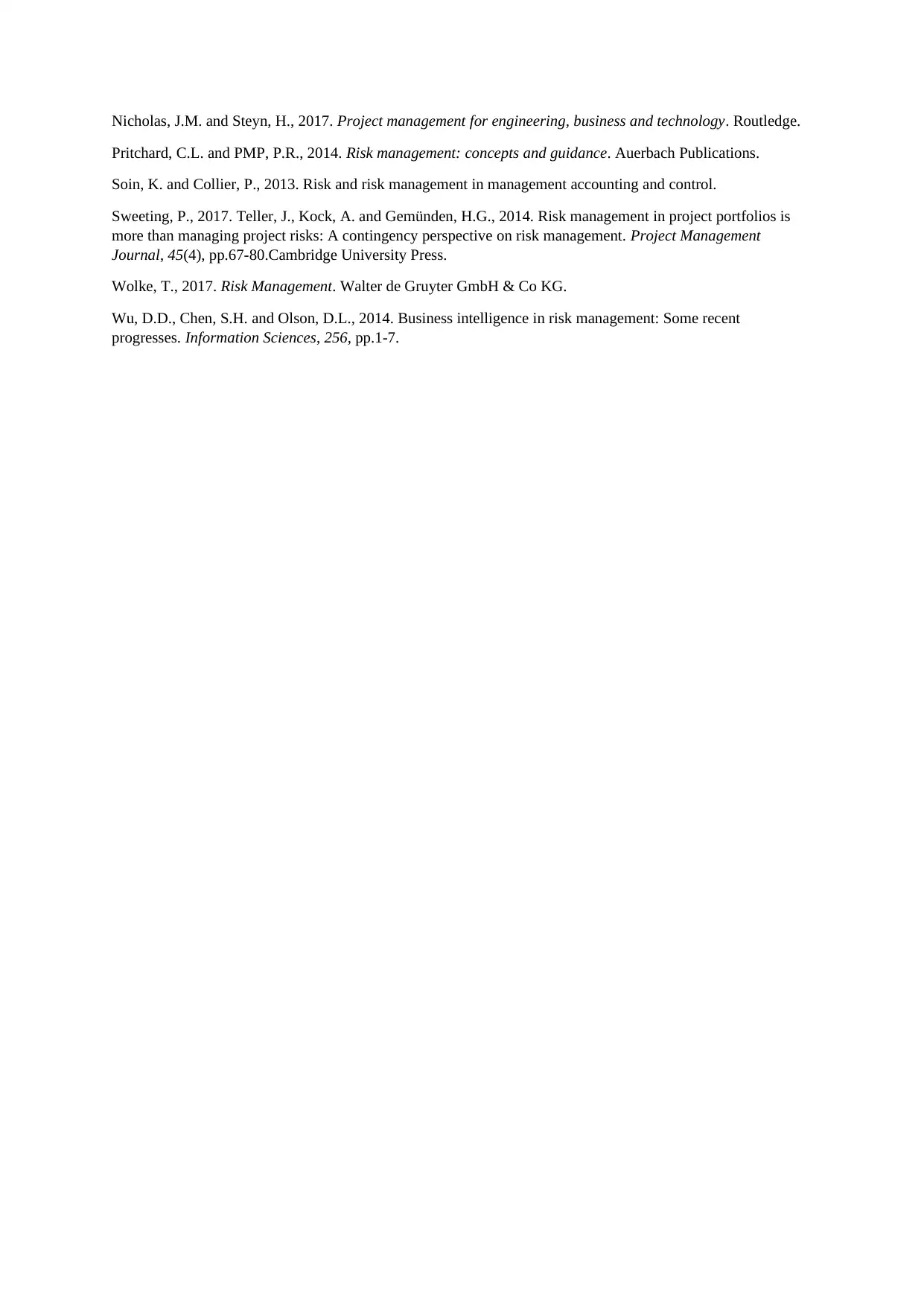
Nicholas, J.M. and Steyn, H., 2017. Project management for engineering, business and technology. Routledge.
Pritchard, C.L. and PMP, P.R., 2014. Risk management: concepts and guidance. Auerbach Publications.
Soin, K. and Collier, P., 2013. Risk and risk management in management accounting and control.
Sweeting, P., 2017. Teller, J., Kock, A. and Gemünden, H.G., 2014. Risk management in project portfolios is
more than managing project risks: A contingency perspective on risk management. Project Management
Journal, 45(4), pp.67-80.Cambridge University Press.
Wolke, T., 2017. Risk Management. Walter de Gruyter GmbH & Co KG.
Wu, D.D., Chen, S.H. and Olson, D.L., 2014. Business intelligence in risk management: Some recent
progresses. Information Sciences, 256, pp.1-7.
Pritchard, C.L. and PMP, P.R., 2014. Risk management: concepts and guidance. Auerbach Publications.
Soin, K. and Collier, P., 2013. Risk and risk management in management accounting and control.
Sweeting, P., 2017. Teller, J., Kock, A. and Gemünden, H.G., 2014. Risk management in project portfolios is
more than managing project risks: A contingency perspective on risk management. Project Management
Journal, 45(4), pp.67-80.Cambridge University Press.
Wolke, T., 2017. Risk Management. Walter de Gruyter GmbH & Co KG.
Wu, D.D., Chen, S.H. and Olson, D.L., 2014. Business intelligence in risk management: Some recent
progresses. Information Sciences, 256, pp.1-7.
1 out of 11
Related Documents
Your All-in-One AI-Powered Toolkit for Academic Success.
+13062052269
info@desklib.com
Available 24*7 on WhatsApp / Email
![[object Object]](/_next/static/media/star-bottom.7253800d.svg)
Unlock your academic potential
Copyright © 2020–2025 A2Z Services. All Rights Reserved. Developed and managed by ZUCOL.




